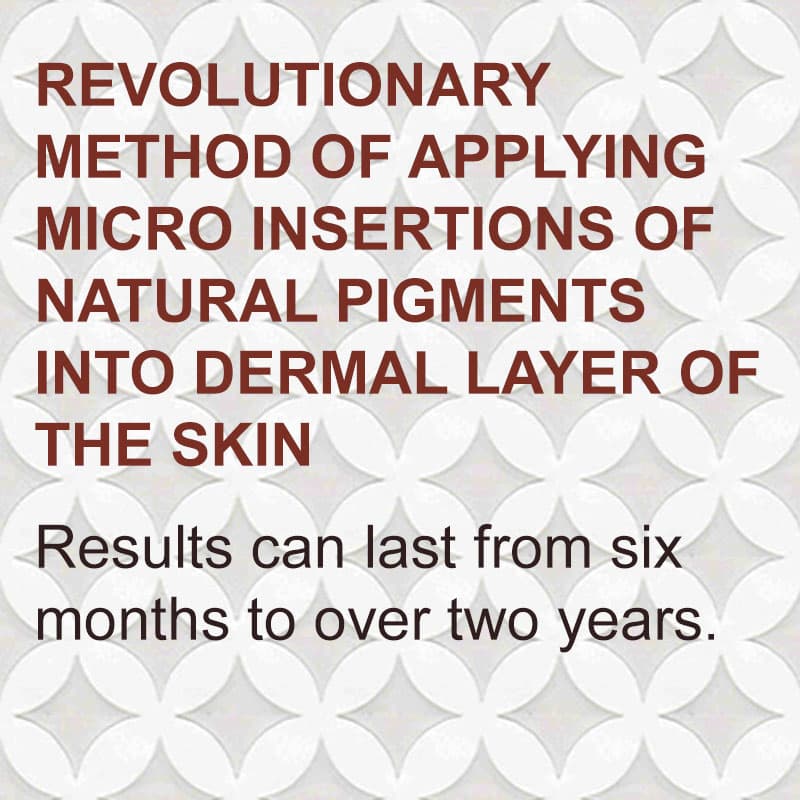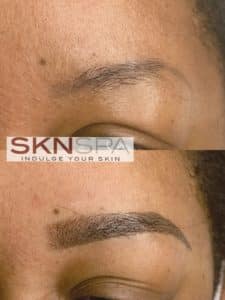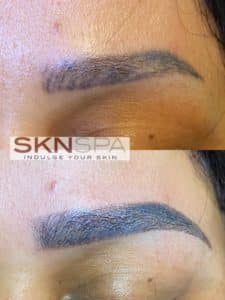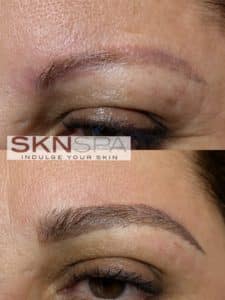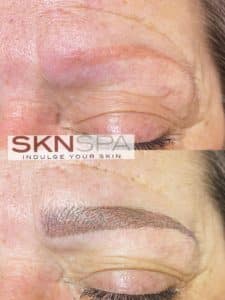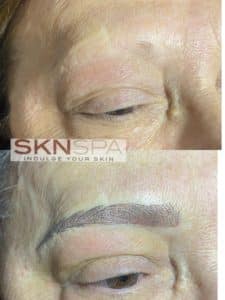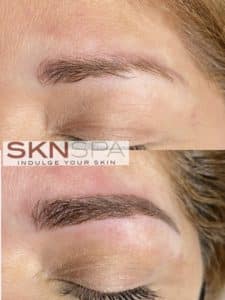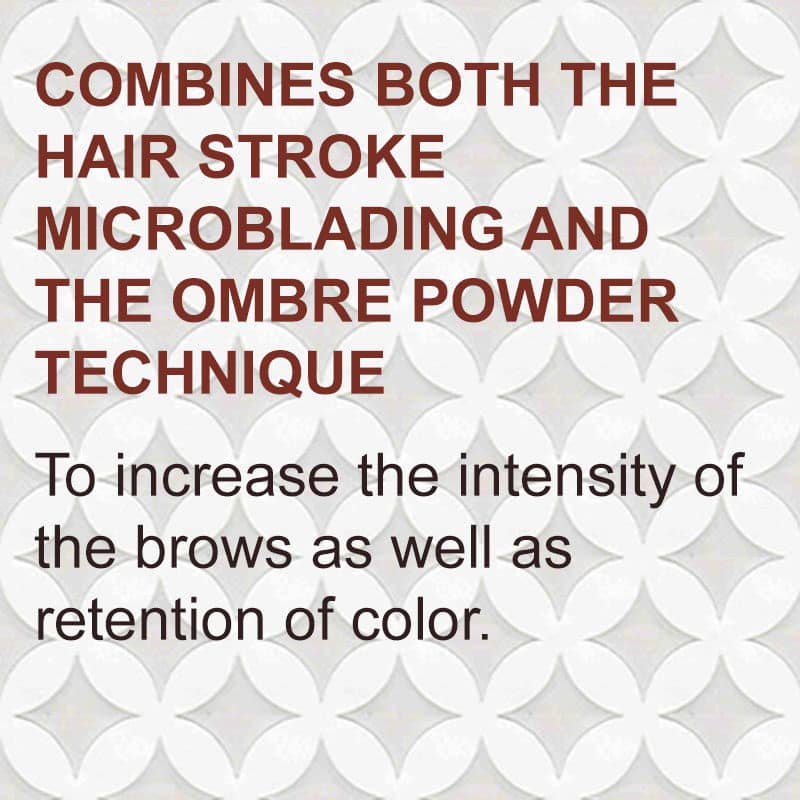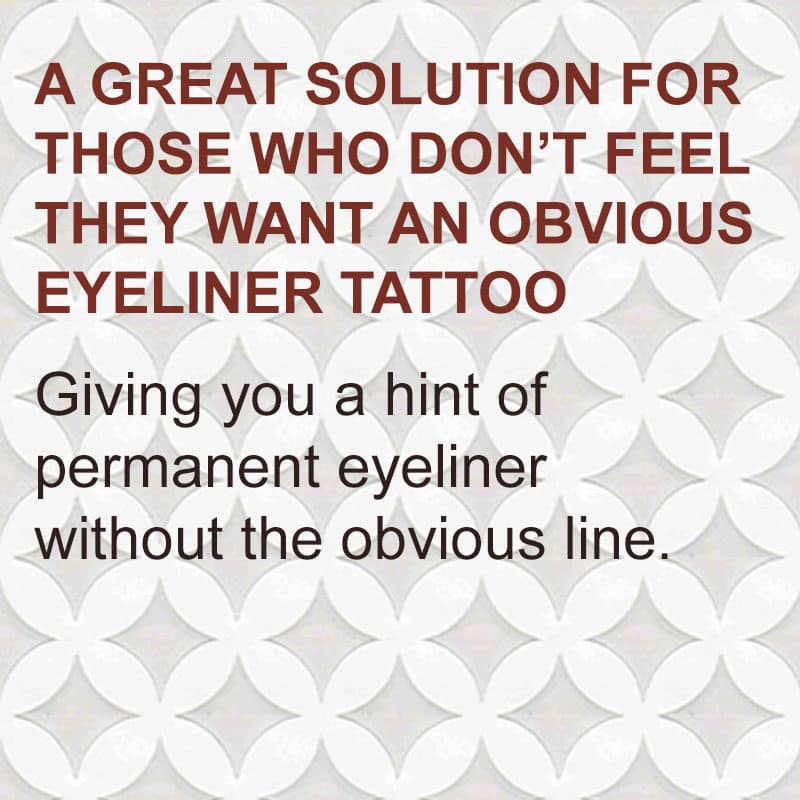3D Microblading $650
Microblading is a semi-permanent cosmetic tattooing technique used to enhance the appearance of eyebrows. It involves using a small, handheld tool with fine needles to create hair-like strokes on the skin, which are filled with pigment to mimic natural eyebrow hairs.
Here are some key aspects of microblading:
- Procedure: During a microblading session, a trained technician or esthetician carefully implants pigment into the upper layers of the skin using a manual tool. The strokes are strategically placed to fill in sparse eyebrows, define shape, or create a fuller appearance.
- Purpose: Microblading is typically used to achieve natural-looking eyebrows, particularly for individuals with thin, over-plucked, or sparse eyebrows. It can also enhance the shape and symmetry of eyebrows for a more defined and polished look.
- Duration: The results of microblading can last anywhere from 1 to 3 years, depending on factors such as skin type, skincare routine, and sun exposure. Touch-up sessions may be needed periodically to maintain the desired shape and color intensity.
- Pigments: Pigments used in microblading are specifically formulated for use on the face and are chosen to match the client’s natural eyebrow color or desired shade. They are semi-permanent and gradually fade over time.
- Procedure Safety: It is essential to choose a licensed and experienced technician for microblading to ensure safety and achieve optimal results. Proper hygiene practices and sterile equipment should always be used to minimize the risk of infection.
- Aftercare: After microblading, it is crucial to follow specific aftercare instructions provided by your technician. This typically includes keeping the eyebrows dry and avoiding activities that could cause sweating or exposure to water for several days. Proper aftercare helps ensure the pigment settles well into the skin and promotes healing.
- Consultation: Before undergoing microblading, a consultation is usually conducted to discuss expectations, desired shape and color, and any concerns. This allows the technician to customize the treatment to suit the client’s preferences and facial features.
Microblading has gained popularity as a semi-permanent solution to achieve natural-looking eyebrows with enhanced shape and definition. It can be a convenient option for individuals looking to streamline their daily beauty routine or address eyebrow concerns effectively.
Here’s a Q&A session focused on microblading:
Q: What is microblading?
A: Microblading is a semi-permanent cosmetic tattooing technique used to enhance the appearance of eyebrows. It involves using a manual handheld tool with fine needles to deposit pigment into the skin, creating hair-like strokes that mimic natural eyebrow hairs.
Q: Who is a good candidate for microblading?
A: Good candidates for microblading include individuals with sparse eyebrows, over-plucked eyebrows, or those looking to enhance the shape and definition of their eyebrows. It is suitable for most skin types, but a consultation with a qualified technician can determine if you’re a good candidate.
Q: How long does microblading last?
A: The results of microblading typically last between 1 to 3 years, depending on factors such as skin type, skincare routine, and sun exposure. Touch-up sessions may be required periodically to maintain the color and shape of the eyebrows.
Q: What is the difference between microblading and eyebrow tattooing?
A: Microblading and traditional eyebrow tattooing differ primarily in technique and the depth at which pigment is implanted into the skin. Microblading uses a manual tool with fine needles to create precise, hair-like strokes in the upper layers of the skin, resulting in a more natural look. Traditional tattooing may use a machine and can penetrate deeper into the skin, resulting in a more permanent effect.
Q: Is microblading painful?
A: Pain tolerance varies among individuals, but most people experience mild discomfort during microblading. Before the procedure, a topical numbing cream is applied to minimize discomfort. Clients may feel slight pressure or scratching sensations as the pigment is implanted.
Q: How should I prepare for a microblading appointment?
A: Before your microblading appointment, avoid waxing or plucking your eyebrows for at least a week to allow your natural brow shape to be assessed. It’s also recommended to avoid alcohol, caffeine, and blood-thinning medications to minimize bleeding during the procedure. Discuss any concerns with your technician during the consultation.
Q: What is the recovery process like after microblading?
A: Immediately after microblading, the treated area may appear darker and more intense, but this fades over the following days as the skin heals. Mild redness and slight swelling may occur, but these typically subside within a few hours to a few days. It’s important to follow post-care instructions provided by your technician, such as keeping the eyebrows dry and avoiding certain skincare products.
Q: How do I choose a microblading technician?
A: When choosing a microblading technician, look for someone who is licensed, certified, and experienced in performing microblading. Ask to see before-and-after photos of their work and read client reviews. A consultation allows you to discuss your goals, ask questions, and ensure you feel comfortable with the technician’s approach.
Q: Can I still wear makeup after microblading?
A: Yes, you can still wear makeup after microblading, but it’s recommended to avoid applying makeup directly on the eyebrows during the initial healing period. Once the skin has fully healed, you can resume your usual makeup routine, taking care to avoid products containing exfoliants or chemicals that may affect the pigment.
These questions and answers provide a comprehensive overview of microblading, helping individuals understand the procedure, expectations, and considerations before undergoing treatment. Always consult with a qualified technician for personalized advice based on your individual needs and preferences.
Post-care after microblading is crucial to ensure proper healing and to maximize the longevity of your new eyebrows. Here are essential post-care tips to follow:
- Keep the eyebrows dry: For the first 7-10 days after microblading, avoid getting your eyebrows wet to allow the pigment to settle properly. This means avoiding activities such as swimming, saunas, steam rooms, and heavy sweating.
- Avoid touching or picking: During the initial healing phase, avoid touching your eyebrows to prevent introducing bacteria to the treated area. Picking at scabs or flakes can also interfere with the healing process and affect the final results.
- Apply recommended ointment: Your microblading technician will provide you with a healing ointment or cream. Apply this as directed to keep the eyebrows moisturized and to aid in the healing process. Use a clean cotton swab to apply the ointment to avoid contamination.
- Avoid makeup on the eyebrows: Avoid applying makeup directly on the eyebrows until the healing process is complete, typically after 7-10 days. Makeup products can introduce bacteria and may interfere with pigment retention.
- Avoid sun exposure and tanning: Protect your eyebrows from direct sunlight and tanning beds during the healing phase and beyond. UV rays can fade the pigment and affect the color of your eyebrows. Use a hat or sunglasses to shield your eyebrows when outdoors, and apply sunscreen with SPF 30 or higher if necessary.
- Avoid sweating and intense exercise: Avoid activities that may cause excessive sweating, such as vigorous exercise, sauna sessions, or hot yoga, for at least a week after microblading. Sweat can affect pigment retention and increase the risk of infection.
- Gentle cleansing: After the initial healing period, gently cleanse your eyebrows with a mild, fragrance-free cleanser and water. Pat them dry with a clean towel; do not rub.
- Attend follow-up appointments: Follow the aftercare instructions provided by your technician and attend any scheduled touch-up appointments. Touch-ups are typically done 4-6 weeks after the initial treatment to refine the shape and ensure even pigment distribution.
- Monitor your healing: Pay attention to any signs of infection, excessive redness, swelling, or unusual discomfort. If you experience any of these symptoms, contact your technician or a healthcare professional promptly.
- Long-term care: To maintain your microbladed eyebrows, avoid using exfoliating skincare products directly on the eyebrows and be cautious with chemical peels and laser treatments that can affect the pigment. Use a gentle moisturizer to keep the skin around your eyebrows hydrated.
By following these post-care tips, you can promote proper healing, enhance the longevity of your microbladed eyebrows, and achieve the best possible results. Always consult with your microblading technician for personalized advice based on your individual healing process and skin type.

